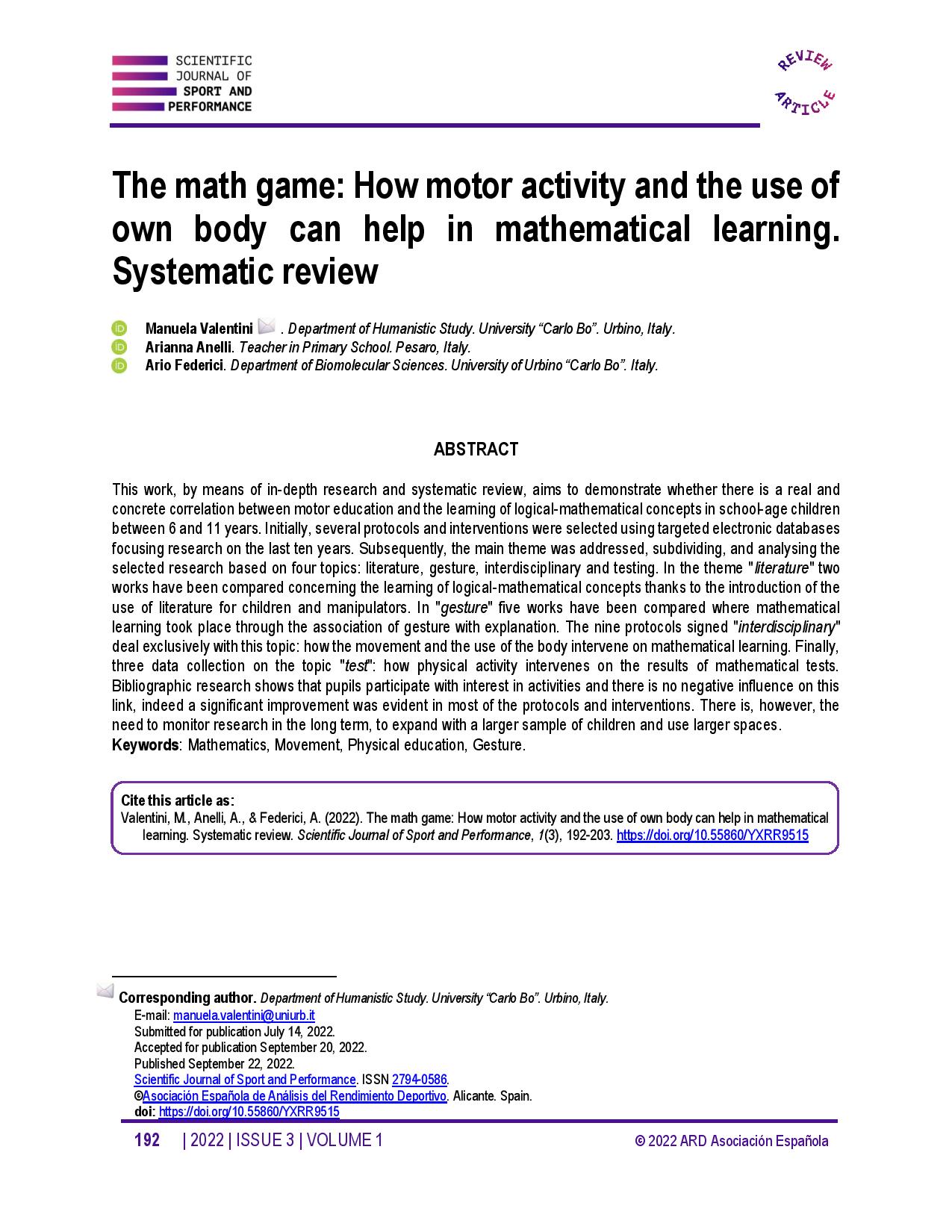The math game How motor activity and the use of own body can help in mathematical learning. Systematic review
Main Article Content
Abstract
This work, by means of in-depth research and systematic review, aims to demonstrate whether there is a real and concrete correlation between motor education and the learning of logical-mathematical concepts in school-age children between 6 and 11 years. Initially, several protocols and interventions were selected using targeted electronic databases focusing research on the last ten years. Subsequently, the main theme was addressed, subdividing, and analysing the selected research based on four topics: literature, gesture, interdisciplinary and testing. In the theme "literature" two works have been compared concerning the learning of logical-mathematical concepts thanks to the introduction of the use of literature for children and manipulators. In "gesture" five works have been compared where mathematical learning took place through the association of gesture with explanation. The nine protocols signed "interdisciplinary" deal exclusively with this topic: how the movement and the use of the body intervene on mathematical learning. Finally, three data collection on the topic "test": how physical activity intervenes on the results of mathematical tests. Bibliographic research shows that pupils participate with interest in activities and there is no negative influence on this link, indeed a significant improvement was evident in most of the protocols and interventions. There is, however, the need to monitor research in the long term, to expand with a larger sample of children and use larger spaces.
Article Details

This work is licensed under a Creative Commons Attribution-NonCommercial-ShareAlike 4.0 International License.
References
Cameron C. E., Brock L. L., Murrah W. M., Bell L. H., Worzalla S. L., Grissmer D., Morrison F. J. (2012). Fine motor skills and executive function both contribute to kindergarten achievement. Child Development, 83, 1229-1244. https://doi.org/10.1111/j.1467-8624.2012.01768.x DOI: https://doi.org/10.1111/j.1467-8624.2012.01768.x
Carlson A. G., Rowe E. W., Curby T. W. (2013). Disentangling fine motor skills' relation to academic achievement: The differential impact of visual-spatial integration and visual motor coordination. Journal of Genetic Psychology, 175, 514-533. https://doi.org/10.1080/00221325.2012.717122 DOI: https://doi.org/10.1080/00221325.2012.717122
Dewey J. (1968). Il mio credo pedagogico. Firenze: La Nuova Italia. Dewey J. (1969). Scuola e società. Firenze: La Nuova Italia.
Federici A., Tonino Cardinali C., Valentini M. (2008). Il corpo educante. Roma: Aracne. Gardner H. (2002). Formae mentis. Saggio sulla pluralità dell'intelligenza. Milano: Feltrinelli.
Grissmer D., Grimm K. J., Aiyer S. M., Murrah W. M., Steele J. S. (2010). Fine motor skills and early comprehension of the world: Two new school readiness indicators. Developmental Psychology, 46, 1008- 1017. https://doi.org/10.1037/a0020104 DOI: https://doi.org/10.1037/a0020104
Golden L. (2012). Children's literature in mathematics instruction. Library Media Connection, 31(2),40-41.
Ministero dell'Istruzione, dell'Università e della Ricerca (2012). Indicazioni nazionali per il curricolo della scuola dell'infanzia e del primo ciclo d'istruzione. Annali della Pubblica istruzione (numero speciale). http://www.scuolagiuntini.it/wp-content/uploads/2021/01/Indicazioni_Nazionali_curricolo_2012.pdf (Verified on date: 21/02/2021).
Meinel K., Shnabel G. (1984). Teoria del movimento. Abbozzo di una teoria della motricità sportiva sotto l'aspetto pedagogico. Roma: Società Stampa Sportiva.
Paas F., Sweller, J. (2012). An evolutionary upgrade of cognitive load theory: using the human motor system and collaboration to support the learning of complex cognitive tasks. Educational Psychology Review, 24(1), 27-45. https://doi.org/10.1007/s10648-011-9179-2 DOI: https://doi.org/10.1007/s10648-011-9179-2
Pestalozzi J. H. (1933), Madre e figlio: l'educazione dei bambini. Firenze: La Nuova Italia. Piaget J. (1966), La rappresentazione del mondo nel fanciullo. Torino: Boringhieri.
Piaget J. (1967), Lo sviluppo mentale del bambino e altri studi di psicologia. Torino: Einaudi. Piaget J. (1973), La costruzione del reale nel bambino. Firenze: La Nuova Italia.
Ping R.M., Goldin-Meadow S. (2008). Hands in the air: Using ungrounded iconic gestures to teach children conservation of quantity. Developmental Psychology, 44, 1277-1287. https://doi.org/10.1037/0012-1649.44.5.1277 DOI: https://doi.org/10.1037/0012-1649.44.5.1277
Pouw W. T. J. L., Van Gog T., Paas F. (2014). An Embedded and Embodied Cognition Review of Instructional Manipulatives. Educational Psychology Review, 26, 51 -72. https://doi.org/10.1007/s10648-014-9255-5 DOI: https://doi.org/10.1007/s10648-014-9255-5
Rousseau J. J. (1989). Emilio o dell'educazione. Roma: Armando Editore.
Singer M.A., Goldin-Meadow S. (2005). Children learn when their teacher's gestures and speech differ. Psychological Science, 16, 85-89. https://doi.org/10.1111/j.0956-7976.2005.00786.x DOI: https://doi.org/10.1111/j.0956-7976.2005.00786.x
Sternberg R. J. e Spear-Swerling L. (1966). Le tre intelligenze. Torino: Edizioni Erickson.
Valenzeno L., Alibali M.W., Klatzky R. (2003). Teachers' gestures facilitate students' learning: A lesson in symmetry. Contemporary Educational Psychology, 28, 187-204. https://doi.org/10.1016/S0361-476X(02)00007-3 DOI: https://doi.org/10.1016/S0361-476X(02)00007-3




